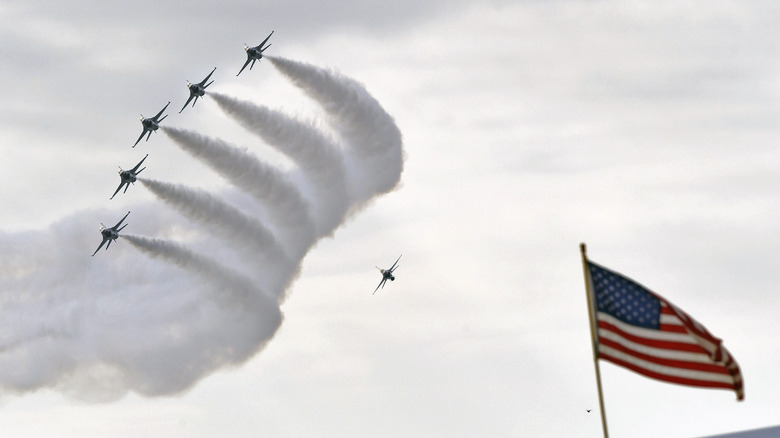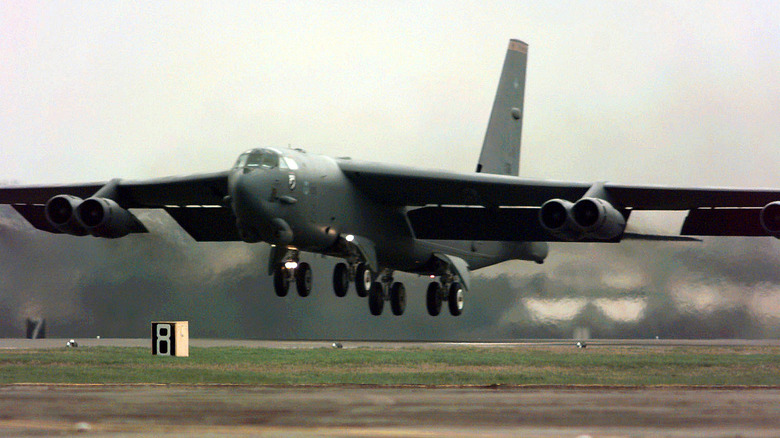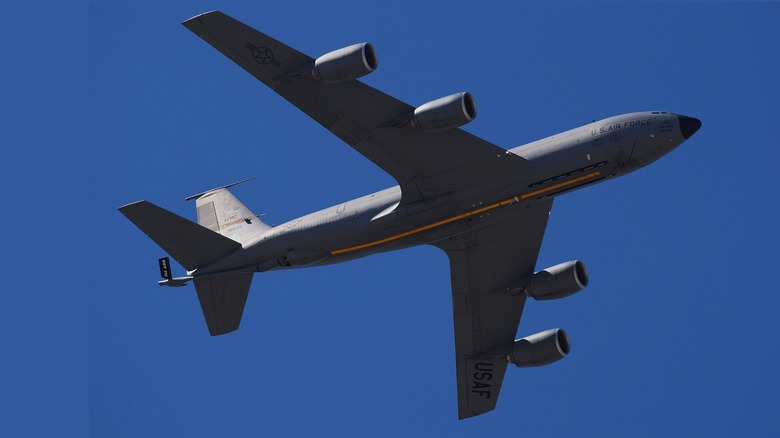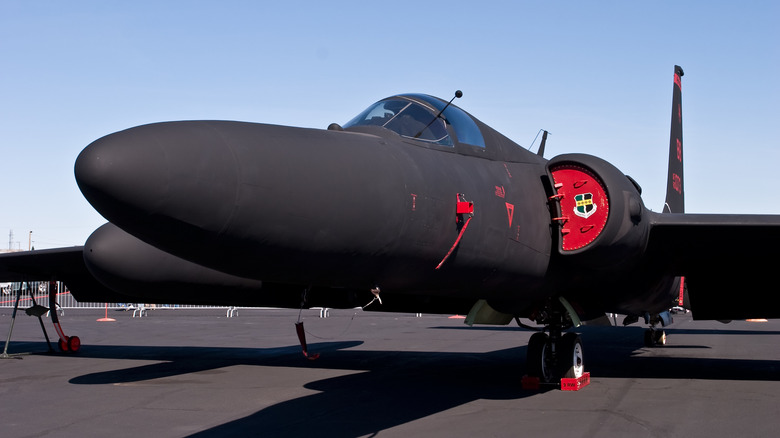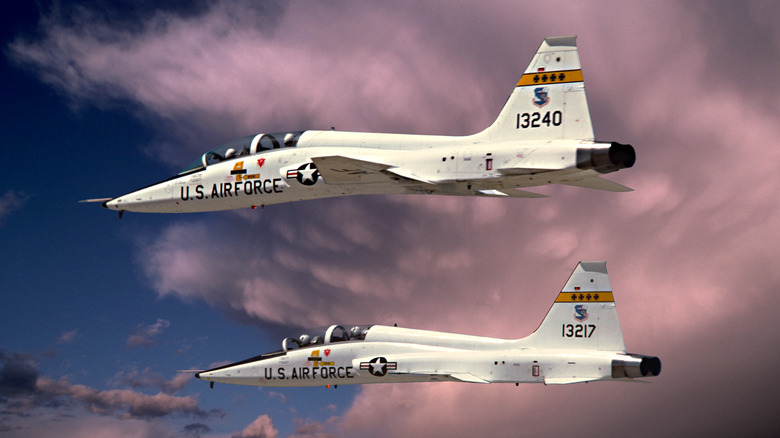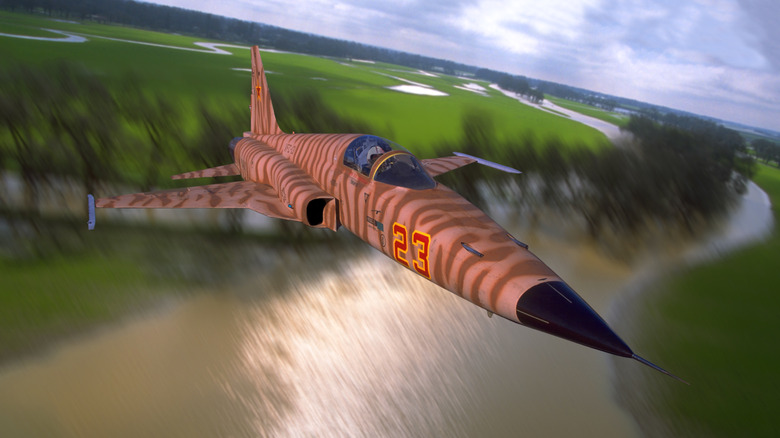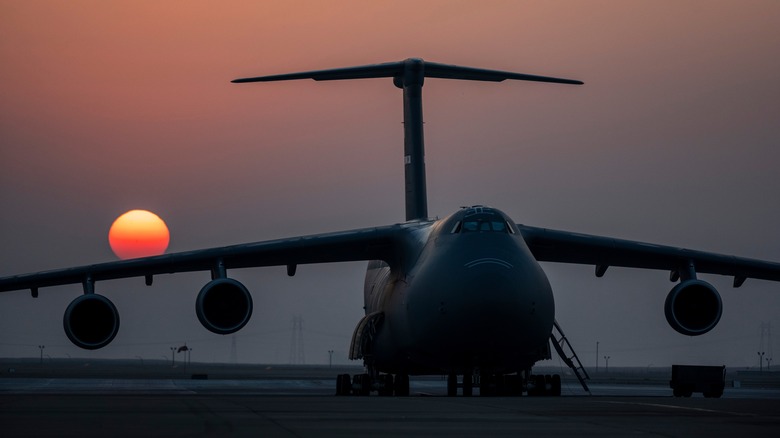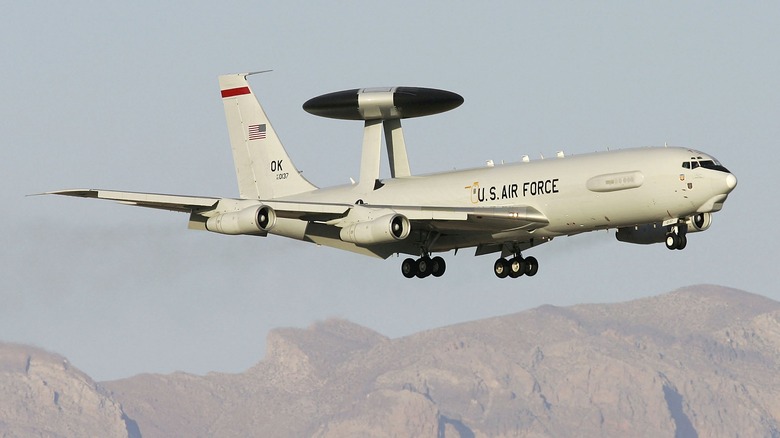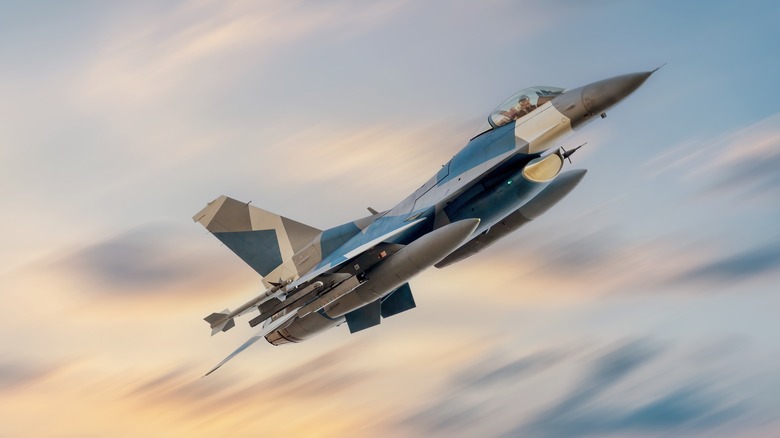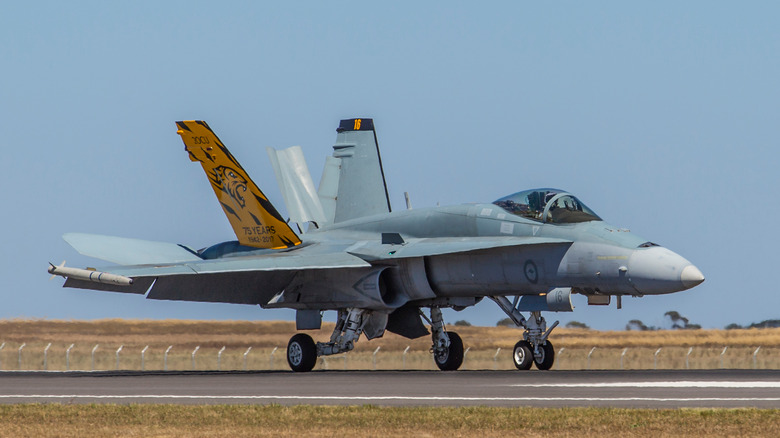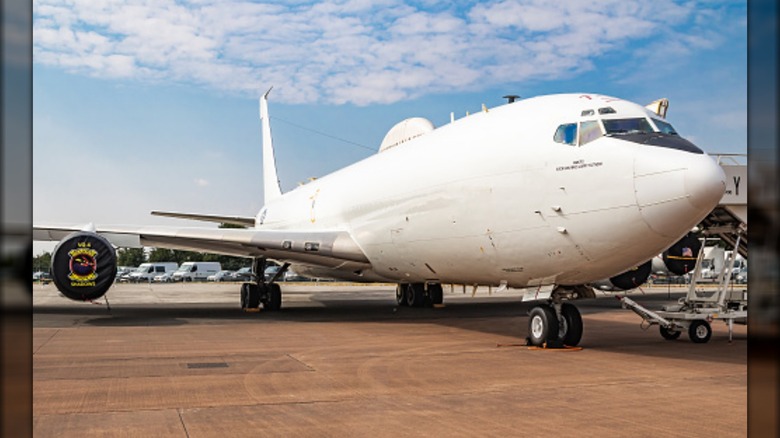10 Of The Oldest American Military Jets Still In Service
Have you ever wondered why some military jets stick around longer than others? The reason some of these old warriors are still in use isn't just by chance. It's because of a mix of key factors: they were built tough, they've been regularly updated, they're versatile, and they still meet a strategic need, even as technology rapidly changes around them.
From the highest reconnaissance missions of the U-2S Dragon Lady to the vital aerial refueling provided by the Stratotanker KC-135R/T, all of the American military jets on this list have a unique story to tell. Whether it's training the next generation of pilots in the T-38A/C Talon or delivering necessary cargo with the C-5M Super Galaxy, each aircraft has a legacy of innovation, adaptability, and service.
We're taking a closer look into the lives of these enduring jets—not only to find out more about their legendary past but also how, to this day, they are still keeping up in the ever-evolving defense landscape. These stories will trace how each has evolved over time, ready to serve aviators for years to come.
B-52H Stratofortress (1955)
The B-52H Stratofortress, affectionately known as BUFF (Big Ugly Fat Fellow), is one of the most enduring examples of American military aircraft. Boeing developed the B-52 bomber in the 1950s to carry atomic bombs to the Soviet Union during the Cold War. While initially a strategic deterrent, over time, the B-52 has adapted to perform various missions, from conventional and strategic bombing to supporting ground troops. Its unique capability to carry up to 20 air-launched cruise missiles made it an extremely versatile and capable aircraft.
Starting in 1965, B-52Ds and Fs flew from Guam, Okinawa, and Thailand for intense bombing campaigns in North and South Vietnam. The B-52G, which also targeted North Vietnam, had a larger fuel capacity and could launch air-to-surface and anti-ship missiles. Fast forward to today, the B-52H has stayed relevant as part of the US Air Force (USAF), with an incredible adaptability record due to ongoing upgrades and modernization efforts.
Looking ahead, the future of the B-52H is just as exciting as its past. In September 2021, the USAF awarded Rolls-Royce a $2.6 billion contract for its replacement of TF33 with 608 new F-130 engines under the Commercial Engine Replacement Program (CERP). This is part of a greater effort to ensure the B-52 stays in service until the 2040s (or 50s). Installing modern engines and avionics and integrating improved weapon systems show the commitment to preserve the B-52H Stratofortress as an asset of the USAF Strategic Bomber Force for the needs of contemporary warfare.
KC-135R/T Stratotanker (1957)
Just as important as the bombers and fighters are the tankers that extend their reach. Built by Boeing, the KC-135R/T Stratotanker was originally designed to be a commercial jetliner. Later, it became an aerial refueling tanker with cargo capabilities, extending to fighters, bombers, and other aircraft the revolution in air combat range, with the ability to refuel them in flight, wherever they operated across the world.
Over the years since the 1950s, the KC-135 has played a key role in many military operations during the Vietnam War, Operation Desert Storm, and the subsequent conflicts in Iraq and Afghanistan. It conducted comprehensive air patrols and long-term support for combat operations.
Though some might see this aircraft as just a flying gas station, its strategic value is hard to ignore. The ability to refuel planes mid-air is crucial for maintaining control over a region's airspace. For many years, the Stratotanker has given the American military this advantage.
The USAF continually upgrades the KC-135 fleet to update the aircraft with new avionics, communication, and navigation systems. These improvements will keep the KC-135 viable for the USAF well into the 2040s. While newer tankers like the KC-46A Pegasus are finding their way into the force, the proven reliability of the KC-135R/T ensures that it will remain the backbone of US refueling operations.
U-2S Dragon Lady (1957)
The U-2S Dragon Lady is an iconic high-altitude reconnaissance aircraft operated by the USAF. The U-2, built in the 1950s by Lockheed's Skunk Works division, has been an eye in the sky for national security missions at altitudes above 70,000 feet for more than 60 years. The U-2S variant of the U-2, with avionics, engines, and a host of other improved sensors, is regarded as the most potent series ever made for surveillance and reconnaissance.
Originally designed for Cold War-era overflights of the Soviet Union, Cuba, and other hostile territories, the U-2 collected high-resolution imagery and signals intelligence in hard-to-reach areas. This made it an invaluable asset for global monitoring and treaty verification during some of the most turbulent political situations of the 20th century. The aircraft has served in various conflicts, supporting operations in the Balkans, the Middle East, and Afghanistan and providing real-time intelligence to the troops on the ground.
Despite discussions of its retirement in favor of unmanned platforms like the RQ-4 Global Hawk, continuous upgrades have been poured into its avionics, sensors, and communication systems. The Air Force has sunk money into modernizing the cockpit with a new avionics suite to improve pilots' safety and mission effectiveness. Potential plans have also been to further boost its intelligence-gathering capability by incorporating ASARS-2 imaging radar and increasing its role in network-centric warfare.
T-38A/C Talon (1961)
The T-38A/C Talon is a twin-engine, high-speed, supersonic jet trainer used by the USAF. Since the early sixties, the T-38 served as the primary advanced trainer for pilot candidates transitioning to high-performance military aircraft. Its speed, agility, and reliability made it an invaluable training tool for generations of pilots in preparing for the rigors of supersonic flight. The C variant got major avionics and systems upgrades to the original A-model to increase training capability and safety.
When the T-38A/C Talon entered service in 1961, it revolutionized pilot training by giving trainees real experience with the high speeds and delicate handling of fighter jets. It soon became the primary training aircraft of the US Air Force, preparing pilots for flying serious combat jets like the F-15E Strike Eagle, F-15C Eagle, F-16 Fighting Falcon, B-1B Lancer, A-10 Thunderbolt, and F-22 Raptor.
The T-38 also plays an adversary role during training missions, simulating an enemy aircraft during exercises conducted at home bases to provide realistic air combat training for active duty pilots.
The Air Force launched the T-X program to replace the T-38 with the Boeing-Saab T-7A Red Hawk. The T-38A/C, however, will stay on to bridge the gap until the T-7A platform is fully operational. In the meantime, the T-38C will continue to receive upgrades to its avionics, safety improvements, and maintenance overhauls to ensure it remains a capable and effective training platform.
F-5F/N Tiger II (1965)
The F-5F/N Tiger II was built by Northrop Grumman in the early 1960s. The Tiger II served in air-to-air combat training and tactical reconnaissance. It was cost-effective, built in both the F (two-seat trainer) and N (navalized) versions. Although it was devised during the Cold War, its simplicity, ease of maintenance, and effective design have guaranteed its continued use to this day, from aggressor training to support roles in the US military.
Intended initially for the Military Assistance Program (MAP), the F-5 quickly proved its excellent performance in combat, reconnaissance, and ground-attack missions. Its capabilities were demonstrated in combat with its debut in the Vietnam War, where it served with distinction in the hands of both US and South Vietnamese pilots. Over the years, the F-5 has equipped the air forces of more than 30 countries, serving roles from air defense to aggressor training, where the performance of the F-5 was just what the doctor ordered to stand in for potential adversaries' aircraft.
Programs such as the Avionics Reconfiguration and Tactical Enhancement/Modernization for Inventory Standardization (ARTEMIS) continue to upgrade the F-5F/N fleet to improve aircraft effectiveness. These include avionic updates, radar systems, and communication capabilities, ultimately ensuring the relevance of aircraft to near-peer threat emulations. If realistic and cost-effective adversary training is needed, then the F-5F/N Tiger II will likely continue playing an important role in preparing US pilots for years to come.
C-5M Super Galaxy (1970)
The C-5M Super Galaxy is a strategic transport aircraft developed by Lockheed Martin and is the current, most advanced model of the classic C-5 Galaxy that began operation in the late 1960s. This behemoth of the skies is designed to airlift oversized loads and provide humanitarian aid around the globe. The C-5M Super Galaxy upgrades include modernized engines and avionics with dramatic improvements in performance and efficiency over previous models.
From the beginning, the C-5 Galaxy has always been a workhorse for the US military, participating in every major conflict and humanitarian mission since the Vietnam War. The C-5 Galaxy class can carry enormous payloads of tanks, helicopters, and sophisticated equipment, providing the maximum possible pace of strategic airlift. The C-5 has played critical roles in Desert Shield/Desert Storm, Iraqi Freedom, and Enduring Freedom by providing necessary equipment and supplies to the US and allied forces.
The C-5M Super Galaxy continues to serve as one of the pillars of the US Air Mobility Command. Its cargo capacity is unmatched by other aircrafts, allowing it to carry out unique missions like transporting large military equipment and other oversized supplies. The Reliability Enhancement and Re-engining Program (RERP) will keep the C-5M maintained and up-to-date, helping to support the strategic airlift capability of the USAF well into the 21st century. These plans include incremental upgrades in technology like new cockpit controls and displays that ensure interoperability with both modern and future air transport infrastructure.
E-3 Sentry (1977)
The E-3 Sentry was conceived in the mid-1970s with a view to producing an aircraft that can provide surveillance, target detection, and battlefield management. This is termed an airborne warning and control system or AWACS. To accomplish this goal, Boeing used a 707 commercial airline body and applied a plethora of modifications. The most striking of which is the 30-foot radar dome that is carried atop the fuselage. The radar, along with a complex system of data collection and processing, provides detailed information to battlefield commanders.
Upon deployment in Operation Desert Storm in the early 1990s, The E-3 Sentry was further utilized as a battle command center, directing ground and air assets while maintaining a clear picture of the battlefield.
Today, the USAF maintains a fleet of 32 Sentry aircraft that are deployed to provide airborne early warning and control capabilities of both the national and NATO defense strategies. They are routinely deployed on peacekeeping missions worldwide in enforcement against the no-fly zone and surveillance missions, including communication support, for both strategic operations and humanitarian missions.
The USAF and its partners initiated a series of modernization efforts to increase the operational life and capabilities of the Sentry with equipment for new electronic warfare, advanced radar systems, and better communication links. In 2023, however, the USAF stopped the project and redirected funding toward building the new E-7A—two prototypes of which should be ready for testing by 2027.
F-16 Fighting Falcon (1978)
The F-16 fighter jet was born in the early 1970s, thanks to the efforts of a coalition of engineers and defense experts known as the Lightweight Fighter Mafia. This group planned to build the F-16 as an alternative to fighter jets that were becoming bulkier and less agile. To achieve this, they worked to incorporate proven systems from other mission-proven aircrafts, such as the F-15 and F-111.
The Fighting Falcon entered service in 1979 to provide the USAF with a versatile air warfare tool. Its excellent maneuverability made it a very capable air-to-air fighter, while its exceptional range (over 500 miles) allowed it to strike deep into enemy territory, well away from its operating base. These qualities made it perfect for deployment with the USAF during Operation Desert Storm in the early 1990s, where it flew more sorties than any other aircraft. On these missions, it was used to strike ground targets and in Operation Allied Force in the late 1990s, it was deployed against enemy air assets with outstanding results.
With over 1,000 units still in active service for the USAF, the fierce Falcon remains a crucial part of today's Air Force fleet. In fact, Lockheed Martin is not done with the F-16 program yet. In 2024 the company began the block 70/72 upgrade rollout. This latest upgrade provides pilots with more advanced battle-focused avionics and allows greater weapons integration. Lockheed Martin is confident that the F-16 Fighting Falcon will remain in service beyond 2060.
F/A-18A Hornet (1985)
The F/A-18 Hornet is a versatile fighter jet platform capable of being deployed in a variety of capacities in all weather conditions. Originally developed by the defunct McDonnell-Douglas company in the 1970s, it was debuted by the United States Marine Corps (USMC) in 1983 and entered service with the United States Navy (USN) the next year.
The full array of the F/A-18 Hornet's capabilities was put on display during Operation Desert Storm at the beginning of the 1990s. During this intense deployment, the fearsome Hornet was required to fulfill bombing missions while, at the same time, shooting down enemy aircrafts. This multi-role capability clearly made quite the impression on the US military's top brass as they proceeded to acquire ever more F/A-18s with more upgrades and mission-specific modifications.
The demand for the F/A-18's multi-role, high-performance prowess has not slowed down despite the development of the next generation of multi-capability fighter jets. The USMC retains the F/A-18 in a number of its latest iterations, which now bear the designation 'Super Hornet'. The Block-II version currently serves aboard USN aircraft carriers and has built a fearsome reputation as a strike fighter and is considered the backbone of the carrier air wing.
Despite the fifth-generation F-35 pushing the envelope of aircraft technology, the ever-reliable F/A-18 still has plenty of air under its wings. With a Block-III iteration currently in testing with the USN, we can expect to see the mighty Super Hornet serving in the skies into the 2030s.
E-6B Mercury (1989)
The E-6B Mercury is the United States Navy's aerial command and information relay center. Essentially, it connects the President and the Pentagon to the US Navy's nuclear assets.
The design is based on Boeing's famous commercial B707 jet airliner but with more than a few alterations and upgrades provided by the engineers at Northrop Grumman. Among these are two trailing antennas that transmit ultra-low frequency signals that can reach deployed nuclear submarines. This ability to relay nuclear launch and strike orders makes it a key part of the last line of defense in case of a full-blown nuclear war.
The crew of 22 have four main missions. Only one of these is to manage the launch and control of intercontinental ballistic missiles. The second mission focuses on testing and maintaining communication abilities. This is achieved by performing launch simulation exercises that involve every step of the nuclear launch sequence as well as day-to-day testing of radio and communications equipment. The third is to manage the information that is sent to, and then transmitted from, the deployed E-6 Mercury. Finally, a team on board is tasked with planning and managing targeting.
The need for a survivable and capable airborne command post is still as strong as ever. In 2022, Northrop Grumman was contracted to perform maintenance and upgrades to the entire E-6 Mercury fleet to the tune of $111 million. It is safe to assume that the E-6 will be commanding from the skies for many more deployments in the future.
